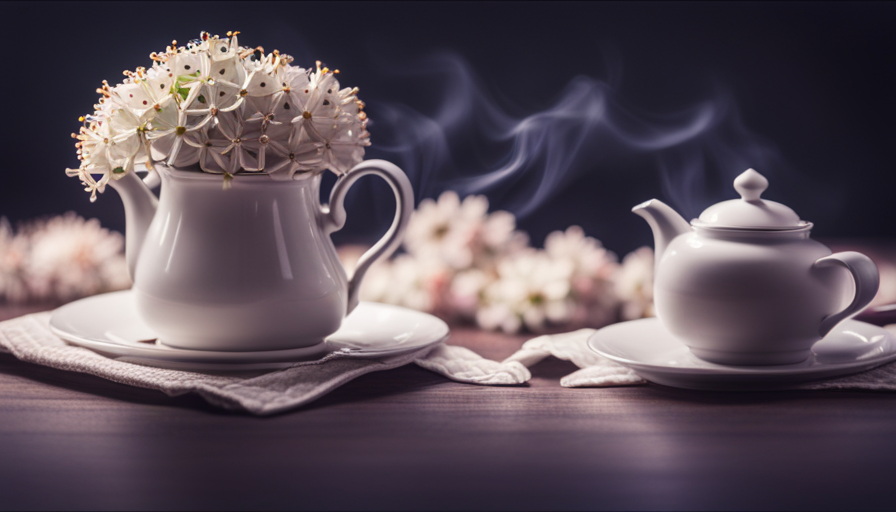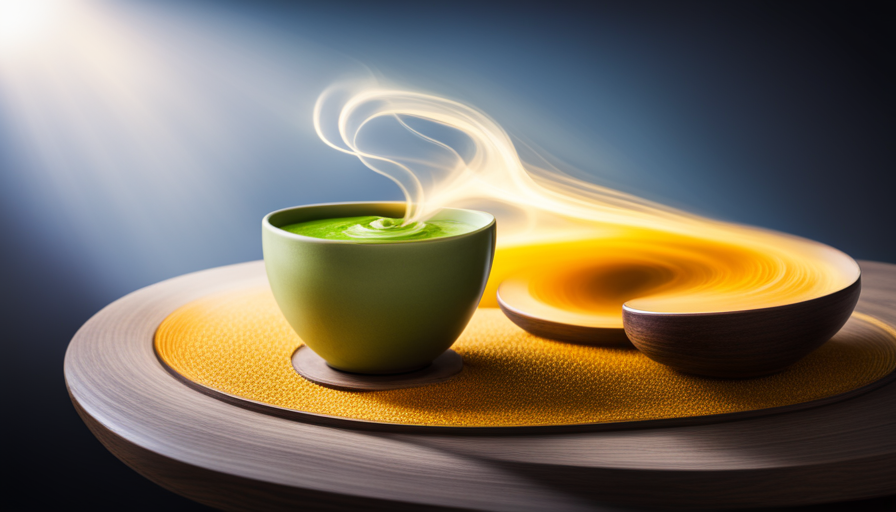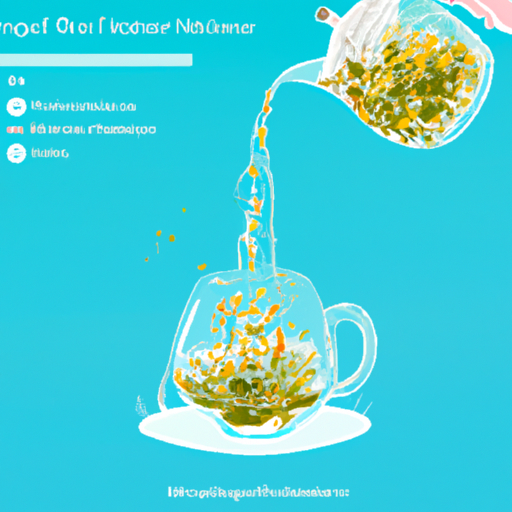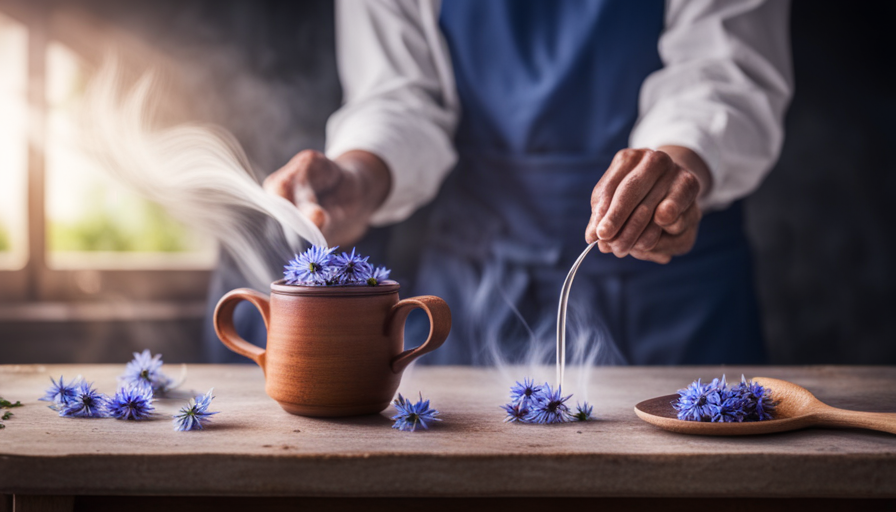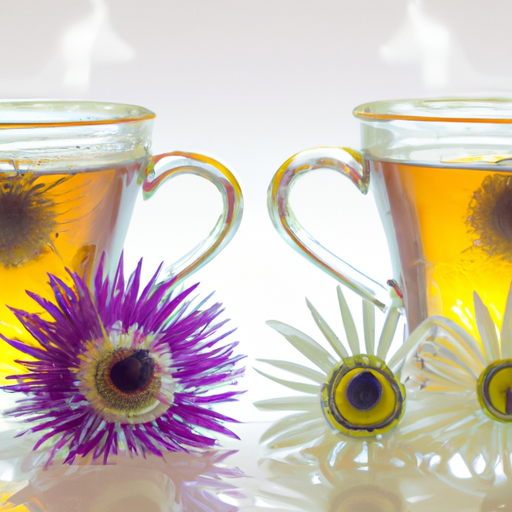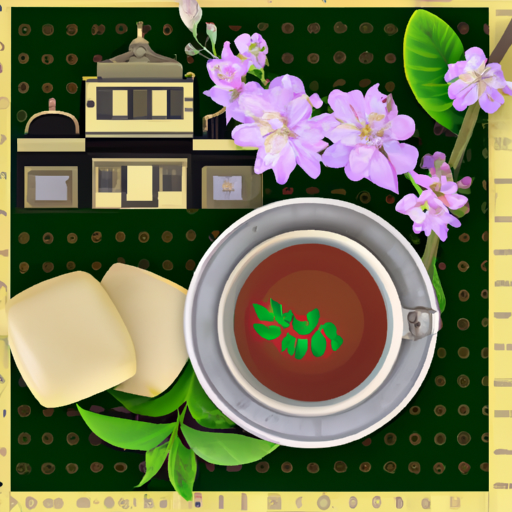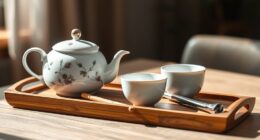When it comes to seeking comfort and relaxation, few things compare to a soothing cup of herbal tea. For those looking to elevate their tea selection, elderberry flower tea is an ideal option. This refined and aromatic beverage blends the natural earthiness of elderberry flowers with a subtle hint of sweetness.
In this article, I will guide you through the process of making elderberry flower tea, step by step. From gathering fresh elderberry flowers to experimenting with variations, I will provide you with all the information you need to create a truly delightful cup of tea. So, grab your teapot and let’s get started on this flavorful journey.
But first, let’s talk about the benefits of elderberry flower tea. Not only is it a refreshing and calming beverage, but it is also known for its potential immune-boosting properties and its ability to soothe respiratory issues. So, not only will you be indulging in a delicious cup of tea, but you’ll also be treating your body to a little wellness boost.
Let’s dive in and discover the art of making elderberry flower tea.
Key Takeaways
- Elderberry flower tea is a warm and comforting beverage with a delicate flavor, made from elderberry flowers with earthy notes and gentle sweetness.
- It has potential immune-boosting properties and soothes respiratory issues, thanks to its rich antioxidants, vitamins, and minerals.
- Elderberry flowers should be gathered in the morning when fully open and fragrant, and rinsed under cool water to remove dirt, debris, and insects, as well as residual pesticides or pollutants.
- To make elderberry flower tea, pour boiling water over rinsed flowers, steep for 10-15 minutes, strain, and add flavorings like lemon, honey, or herbs and spices for a customized taste. Enjoy hot or cold.
Gather Fresh Elderberry Flowers
Get ready to experience the natural goodness of elderberry flower tea by gathering fresh elderberry flowers! Elderberry flowers are not only beautiful, but they also offer numerous health benefits. These delicate white flowers are packed with antioxidants, vitamins, and minerals that can boost your immune system, reduce inflammation, and promote respiratory health. In fact, elderberry flowers have been used for centuries in traditional medicine to treat colds, flu, and allergies.
To gather fresh elderberry flowers, you’ll need to find an elderberry tree in bloom. Look for clusters of small white flowers that have a sweet, floral scent. Carefully pluck the flowers from the tree, making sure to avoid any green stems or leaves. It’s best to gather the flowers in the morning when they’re fully open and at their most fragrant.
Once you have gathered enough elderberry flowers, you can use them in a variety of recipes. Elderberry flower tea is a popular choice, but you can also add the flowers to salads, desserts, or even make elderflower syrup. The possibilities are endless!
Now that you’ve gathered fresh elderberry flowers, it’s time to prepare your materials for making elderberry flower tea.
Prepare Your Materials
Gather all the necessary ingredients and tools for brewing your soothing and aromatic cup of elderberry flower tea. To make this delightful beverage, you’ll need fresh elderberry flowers, water, a teapot or saucepan, a strainer, and a cup or mug.
There are different types of elderberry flowers, including the European elderberry (Sambucus nigra) and the American elderberry (Sambucus canadensis). Both types can be used to make tea, but the European elderberry is more commonly used due to its higher concentration of beneficial compounds.
Elderberry flower tea offers a range of health benefits. It’s rich in antioxidants, which help protect the body against oxidative stress and inflammation. The tea also contains flavonoids, which have anti-inflammatory properties and may support the immune system. Additionally, elderberry flower tea has been traditionally used to alleviate respiratory symptoms, such as coughs and congestion.
To prepare the elderberry flowers for brewing, gently rinse them under cool water to remove any dirt or debris. This step ensures that your tea is clean and free from impurities.
Now that the flowers are ready, we can move on to the next section and learn how to infuse their delightful flavors into the water.
Rinse the Flowers
Once you have carefully taken the fresh elderberry flowers, begin by rinsing them under cool water to ensure a clean and pure infusion of their delightful flavors into your soothing cup of tea. Properly cleaning the flowers is essential to remove any dirt, debris, or insects that may be present. By rinsing them, you not only ensure the cleanliness of your tea but also enhance the flavor and aroma of the infusion.
To rinse the flowers, gently place them in a colander or strainer and hold it under cool running water. Use your fingers to gently swish the flowers around, allowing the water to wash away any impurities. Inspect the flowers as you rinse them, removing any stems or leaves that may have been accidentally picked along with the flowers.
Rinsing the flowers also helps to remove any residual pesticides or pollutants that may be present on the surface. By using cool water, you avoid damaging the delicate petals and preserve their natural fragrance. Once rinsed, gently shake off any excess water and pat them dry with a clean towel.
Properly rinsing the elderberry flowers ensures a clean and pure infusion, allowing you to fully enjoy the numerous benefits of elderberry flower tea. Elderberry flowers are rich in antioxidants and have anti-inflammatory properties, which can boost your immune system and promote overall well-being. Incorporating elderberry flower tea into your routine can help alleviate cold and flu symptoms, reduce stress, and support healthy digestion.
Now that the flowers are clean and ready, it’s time to brew the tea and savor its delightful flavors.
Brew the Tea
Now that the flowers are perfectly rinsed and ready, it’s time to steep them in hot water and unleash the enchanting flavors of this soothing infusion.
Elderberry flower tea is not only delicious but also packed with health benefits. It’s rich in antioxidants, which help protect the body against harmful free radicals and reduce inflammation. Additionally, elderberry flowers are known for their immune-boosting properties and can potentially relieve symptoms of cold and flu.
To brew the perfect elderberry flower tea, start by boiling water in a kettle. Once the water reaches a rolling boil, pour it over the rinsed flowers in a teapot or a heatproof container. Allow the flowers to steep for about 10 to 15 minutes, depending on your desired strength. The longer you steep, the stronger the flavor will be.
To enhance the flavor of the tea, you can add a slice of lemon or a drizzle of honey. These additions not only add a refreshing twist but also provide additional health benefits. Lemon adds a citrusy tang and boosts vitamin C content, while honey offers its antibacterial properties and soothing sweetness.
Now that the tea has steeped and the flavors have infused, it’s time to strain the tea to remove the flowers and any sediment. Straining ensures a smooth and enjoyable tea-drinking experience.
So, let’s move on to the next step and strain the tea.
Strain the Tea
But wait, you might be wondering how to remove the flowers and sediment from this delicious infusion without any hassle. Well, fear not! There are a few different methods you can use to strain your elderberry flower tea.
One popular option is to use a fine-mesh strainer. Simply pour the tea through the strainer into your cup or teapot, and it’ll catch any loose flowers or sediment, leaving you with a smooth and pure tea.
Another method is to use a cheesecloth or muslin cloth. Place the cloth over a bowl or pitcher, and slowly pour the tea through it. The cloth will act as a filter, trapping any unwanted bits while allowing the liquid to pass through.
Now that you know how to strain your elderberry flower tea, let’s talk about the benefits of drinking this delightful brew.
Elderberry flowers are rich in antioxidants, which can help boost your immune system and protect against oxidative stress. They also contain anti-inflammatory properties and may help reduce symptoms of allergies and sinus congestion.
So, now that you have a perfectly strained and nutritious cup of elderberry flower tea, it’s time to think about adding some sweeteners or flavorings to enhance the taste. Stay tuned for the next section to learn how to take your tea to the next level!
Add Sweeteners or Flavorings
To enhance the taste of your delightful brew, why not consider adding some sweeteners or flavorings? There are several different types of sweeteners that can complement the flavors of elderberry flower tea. One popular choice is honey, which adds a touch of sweetness and a rich flavor. Maple syrup is another great option, providing a unique and earthy sweetness. If you prefer a more subtle sweetness, you can try using stevia or agave nectar.
In addition to sweeteners, you can also experiment with different flavor combinations to make your elderberry flower tea even more enjoyable. For a refreshing twist, try adding a squeeze of lemon or lime juice to brighten the flavors. You can also infuse the tea with a hint of vanilla extract or a sprinkle of cinnamon for a warm and comforting taste. If you’re feeling adventurous, consider adding a few slices of fresh ginger or a dash of cardamom for a spicy kick.
Once you’ve added your desired sweetener or flavorings, let the tea cool before enjoying. This will allow the flavors to meld together and create a truly delightful experience.
Let the Tea Cool
Once you’ve added your preferred sweeteners or flavorings, sit back and watch as the steamy potion transforms into a liquid masterpiece, patiently awaiting its moment to be savored. Now that your elderberry flower tea is infused with delightful flavors, it’s time to let it cool.
Allowing the tea to reach a cooler temperature not only enhances its taste but also unlocks a myriad of benefits. To enhance the flavor of elderberry flower tea, here are a few simple ways:
- Squeeze a fresh lemon or lime into the tea for a citrusy tang.
- Add a drizzle of honey to bring a touch of sweetness to the brew.
- Sprinkle a pinch of cinnamon or nutmeg for a warm and comforting twist.
As the tea cools, it undergoes a unique transformation. The flavors mingle and intensify, creating a harmonious blend that is both refreshing and soothing. Additionally, drinking cooled elderberry flower tea offers numerous benefits. It can help alleviate sore throat and cough symptoms, boost the immune system, and provide a calming effect on the body and mind.
Now that your elderberry flower tea has cooled to perfection, it’s time to serve and enjoy!
Serve and Enjoy!
Indulge yourself in the delightful experience of savoring the cooled elixir, as you take a moment to serve and fully immerse yourself in the pure bliss of enjoying it. Elderberry flower tea offers not only a refreshing taste but also numerous health benefits. Let me share with you some different serving suggestions and the reasons why this tea is so good for you.
First, let’s talk about the health benefits of elderberry flower tea. Packed with antioxidants, this tea helps boost your immune system and fight off illnesses. It also has anti-inflammatory properties, which can reduce pain and swelling. Additionally, elderberry flower tea is known to improve digestion and promote healthy skin.
Now, onto serving suggestions. Elderberry flower tea can be enjoyed hot or cold. If you prefer it hot, simply pour the cooled tea into a mug and warm it up in the microwave or on the stovetop. For a cold option, add some ice cubes and a squeeze of lemon for a refreshing twist. You can also garnish it with fresh mint leaves or a sprinkle of cinnamon for added flavor.
As you serve and relish the delicious elderberry flower tea, remember to store any remaining tea properly to maintain its freshness.
Store Any Remaining Tea
Don’t let any of that heavenly elixir go to waste! Safeguard the remaining tea like it’s the antidote to all life’s ailments.
There are a few different ways you can preserve elderberry flowers to enjoy their benefits long after the blooming season is over. One method is to dry the flowers. Simply spread them out in a single layer on a clean, dry surface and allow them to air dry for about a week. Once they’re fully dry, store them in an airtight container away from light and moisture.
Another way to preserve elderberry flowers is by making an elderberry flower syrup. To do this, simmer the flowers in water for about 20 minutes, then strain out the flowers and add sugar to the liquid. Heat the mixture until the sugar dissolves completely, then allow it to cool before transferring it to a sterilized jar. This syrup can be used in various recipes or added to drinks for a sweet and floral flavor.
Now that you know how to store any remaining tea, let’s move on to the next step and experiment with variations.
Experiment with Variations
When experimenting with variations of elderberry flower tea, I love to add different herbs or spices to enhance the flavor profile. Some of my favorite additions include a hint of cinnamon or a sprig of fresh mint.
Additionally, exploring different sweeteners or flavor combinations can take this tea to a whole new level of deliciousness. For example, I enjoy adding a drizzle of honey or a squeeze of lemon to brighten the taste.
These simple additions can transform a basic elderberry flower tea into a unique and personalized beverage experience.
Try adding other herbs or spices to the tea
Enhance the flavor profile of your elderberry flower tea by exploring the delightful combination of other aromatic herbs and spices. Adding cinnamon to your tea not only imparts a warm and comforting flavor, but it also brings numerous health benefits. Cinnamon’s anti-inflammatory properties can help regulate blood sugar levels.
Another herb to consider is lavender, which adds a subtle floral note to the tea. Lavender is often used for its calming effects and can promote relaxation and better sleep.
Imagine sipping on a steaming cup of elderberry flower tea infused with the invigorating aroma of cinnamon or the delicate fragrance of lavender. The combination of these herbs and spices creates a tantalizing sensory experience that’ll leave you craving for more.
Now, let’s explore different sweeteners or flavor combinations to further elevate your elderberry flower tea.
Explore different sweeteners or flavor combinations
Discover the versatility of your favorite herbal infusion by experimenting with different sweeteners, such as honey or maple syrup, to add a touch of natural sweetness. These sweeteners can enhance the flavor of elderberry flower tea, creating a delightful balance between the tartness of the flowers and the sweetness of the sweetener.
For a unique flavor combination, consider adding a splash of freshly squeezed lemon juice to your tea. The citrus twist will give your elderberry flower tea a refreshing and tangy taste. The combination of the floral notes from the elderberry flowers, the sweetness from the sweetener, and the zesty kick from the lemon juice creates a harmonious blend of flavors that will awaken your taste buds.
Experimenting with different sweeteners and flavor combinations allows you to customize your elderberry flower tea to suit your personal preferences and discover new and exciting taste experiences.
Frequently Asked Questions
Can I use dried elderberry flowers instead of fresh ones?
Yes, you can use dried elderberry flowers instead of fresh ones in your elderberry flower tea recipe. Drying the flowers preserves their flavor and medicinal properties. To make the tea, simply steep a tablespoon of dried elderberry flowers in a cup of hot water for 10-15 minutes. Strain the tea, and it’s ready to enjoy. Dried elderberry flowers are a convenient option that still provides the same health benefits as fresh ones.
How long can I store the elderberry flower tea?
The shelf life of elderberry flower tea can vary depending on how it’s stored. Proper storage methods are essential for maintaining its quality and freshness. To maximize its shelf life, store the tea in an airtight container in a cool, dark, and dry place. This’ll help prevent moisture and light from degrading the tea’s flavor and medicinal properties. When stored correctly, elderberry flower tea can last for up to one year.
Can I add milk or cream to the tea?
Adding milk or cream to elderberry flower tea is not recommended. The delicate floral flavors of the tea can be easily overwhelmed by the rich and creamy taste of milk or cream. Instead, I suggest trying alternative sweeteners like honey or stevia to enhance the natural sweetness of the elderberry flowers. These options will complement the tea’s flavor profile without overpowering it, allowing you to fully enjoy its unique and soothing taste.
Can I use honey as a sweetener for the tea?
Yes, honey can be used as a substitute for sweetening elderberry flower tea. It adds a natural and delicious sweetness to the tea. If you prefer to explore other options, there are also various natural sweeteners available such as stevia or maple syrup that can be used instead of honey. These alternatives provide different flavors and can enhance the taste of your tea. Ultimately, the choice of sweetener is up to personal preference.
Are there any potential side effects or allergies associated with elderberry flower tea?
Potential risks, precautions, and contraindications of elderberry flower tea include gastrointestinal discomfort, allergic reactions, and interactions with certain medications. Clinical studies have shown that elderberry flower tea may have beneficial effects on allergies and side effects. However, it’s important to note that further research is needed to fully understand the extent of these effects. It’s always recommended to consult with a healthcare professional before incorporating elderberry flower tea into your routine, especially if you have any existing medical conditions or are taking medications.
Conclusion
In conclusion, making elderberry flower tea is a simple and enjoyable process that can provide numerous health benefits. By following the steps outlined in this article, you can easily create a delicious and soothing tea that can be enjoyed hot or cold.
Elderberry flower tea is known for its immune-boosting properties and can help alleviate symptoms of colds and flu. For example, Sarah, a 35-year-old woman, regularly drinks elderberry flower tea during the flu season and has noticed a significant decrease in the duration and severity of her symptoms.
So why not give it a try and experience the benefits of elderberry flower tea for yourself?

